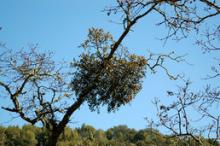Mistletoe: A Festive Parasite
I'm sure you have heard of mistletoe, that cute little sprig that hangs overhead to garner kisses during the holiday season. But did you know that it's actually a parasite?
Mistletoe is a hemi-parasite, which means that it both draws sustenance from the host plant, and uses photosynthesis to feed itself. (The chlorophyll it uses for photosynthesis is responsible for the plant's festive green color.)
Parasitic plants are somewhat rare, with about 4,100 species in existence according to Wikipedia. (Out of about 350,000 total plant species in the world.) Mistletoe parasitizes the stems and branches of other plants, particularly trees.
Mistletoe is a hemi-parasite, which means that it both draws sustenance from the host plant, and uses photosynthesis to feed itself. (The chlorophyll it uses for photosynthesis is responsible for the plant's festive green color.)
Parasitic plants are somewhat rare, with about 4,100 species in existence according to Wikipedia. (Out of about 350,000 total plant species in the world.) Mistletoe parasitizes the stems and branches of other plants, particularly trees.
